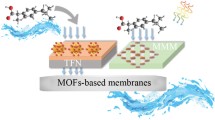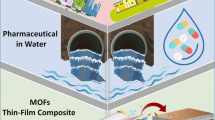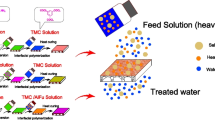Abstract
Metal organic framework (MOF) incorporated thin-film nanocomposite (TFN) membranes have the potential to enhance the removal of endocrine disrupting compounds (EDCs). In MOF-TFN membranes, water transport nanochannels include (i) pores of polyamide layer, (ii) pores in MOFs and (iii) channels around MOFs (polyamide-MOF interface). However, information on how to tune the nanochannels to enhance EDCs rejection is scarce, impeding the refinement of TFN membranes toward efficient removal of EDCs. In this study, by changing the polyamide properties, the water transport nanochannels could be confined primarily in pores of MOFs when the polyamide layer became dense. Interestingly, the improved rejection of EDCs was dependent on the water transport channels of the TFN membrane. At low monomer concentration (i.e., loose polyamide structure), the hydrophilic nanochannels of MIL-101(Cr) in the polyamide layer could not dominate the membrane separation performance, and hence the extent of improvement in EDCs rejection was relatively low. In contrast, at high monomer concentration (i.e., dense polyamide structure), the hydrophilic nanochannels of MIL-101(Cr) were responsible for the selective removal of hydrophobic EDCs, demonstrating that the manipulation of water transport nanochannels in the TFN membrane could successfully overcome the permeability and EDCs rejection trade-off. Our results highlight the potential of tuning primary selective nanochannels of MOF-TFN membranes for the efficient removal of EDCs.

Similar content being viewed by others
References
Boo C, Wang Y, Zucker I, Choo Y, Osuji C O, Elimelech M (2018). High performance nanofiltration membrane for effective removal of perfluoroalkyl substances at high water recovery. Environmental Science & Technology, 52(13): 7279–7288
Costa M, Klein C B (2006). Toxicity and carcinogenicity of chromium compounds in humans. Critical Reviews in Toxicology, 36(2): 155–163
Dai R, Guo H, Tang C Y, Chen M, Li J, Wang Z (2019). Hydrophilic selective nanochannels created by metal organic frameworks in nanofiltration membranes enhance rejection of hydrophobic endocrine-disrupting compounds. Environmental Science & Technology, 53(23): 13776–13783
Dai R, Wang X, Tang C Y, Wang Z (2020). Dually charged MOF-Based thin-film nanocomposite nanofiltration membrane for enhanced removal of charged pharmaceutically active compounds. Environmental Science & Technology, 54(12): 7619–7628
Ferey G (2005). A chromium terephthalate-based solid with unusually large pore volumes and surface area. Science, 309(5743): 2040–2042
Guo H, Deng Y, Tao Z, Yao Z, Wang J, Lin C, Zhang T, Zhu B, Tang C Y (2016). Does hydrophilic polydopamine coating enhance membrane rejection of hydrophobic endocrine-disrupting compounds. Environmental Science & Technology Letters, 3(9): 332–338
Guo H, Deng Y, Yao Z, Yang Z, Wang J, Lin C, Zhang T, Zhu B, Tang C Y (2017a). A highly selective surface coating for enhanced membrane rejection of endocrine disrupting compounds: Mechanistic insights and implications. Water Research, 121: 197–203
Guo H, Yao Z, Yang Z, Ma X, Wang J, Tang C Y (2017b). A one-step rapid assembly of thin film coating using green coordination complexes for enhanced removal of trace organic contaminants by membranes. Environmental Science & Technology, 51(21): 12638–12643
Hering J G, Ingold K M (2012). Water resources management: What should be integrated? Science, 336(6086): 1234–1235
Hwang Y K, Hong D Y, Chang J S, Jhung S H, Seo Y K, Kim J, Vimont A, Daturi M, Serre C, Férey G (2008). Amine grafting on coordinatively unsaturated metal centers of MOFs: Consequences for catalysis and metal encapsulation. Angewandte Chemie International Edition, 120(22): 4212–4216
Kang Y, Obaid M, Jang J, Kim I S (2019). Sulfonated graphene oxide incorporated thin film nanocomposite nanofiltration membrane to enhance permeation and antifouling properties. Desalination, 470: 114125
Kimura K, Toshima S, Amy G, Watanabe Y (2004). Rejection of neutral endocrine disrupting compounds (EDCs) and pharmaceutical active compounds (PhACs) by RO membranes. Journal of Membrane Science, 245(1–2): 71–78
Lau W J, Gray S, Matsuura T, Emadzadeh D, Paul Chen J, Ismail A F (2015). A review on polyamide thin film nanocomposite (TFN) membranes: History, applications, challenges and approaches. Water Research, 80: 306–324
Li J R, Sculley J, Zhou H C (2012). Metal-organic frameworks for separations. Chemical Reviews, 112(2): 869–932
Li M, Liang S, Wu Y, Yang M, Huang X (2020). Cross-stacked super-aligned carbon nanotube/activated carbon composite electrodes for efficient water purification via capacitive deionization enhanced ultrafiltration. Frontiers of Environmental Science & Engineering, 14(6): 107
Li Y, Chung T S, Cao C, Kulprathipanja S (2005). The effects of polymer chain rigidification, zeolite pore size and pore blockage on polyethersulfone (PES)-zeolite A mixed matrix membranes. Journal of Membrane Science, 260(1–2): 45–55
Liu D, Cabrera J, Zhong L, Wang W, Duan D, Wang X, Liu S, Xie Y (2021). Using loose nanofiltration membrane for lake water treatment: A pilot study. Frontiers of Environmental Science & Engineering, 15(4): 69
Luo J, Wan Y (2013). Effects of pH and salt on nanofiltration: A critical review. Journal of Membrane Science, 438: 18–28
Luo Y, Guo W, Ngo H H, Nghiem L D, Hai F I, Zhang J, Liang S, Wang X C (2014). A review on the occurrence of micropollutants in the aquatic environment and their fate and removal during wastewater treatment. Science of the Total Environment, 473–474: 619–641
Ma D, Han G, Peh S B, Chen S B (2017). Water-stable metal-organic framework UiO-66 for performance enhancement of forward osmosis membranes. Industrial & Engineering Chemistry Research, 56(44): 12773–12782
Pacheco F A, Pinnau I, Reinhard M, Leckie J O (2010). Characterization of isolated polyamide thin films of RO and NF membranes using novel TEM techniques. Journal of Membrane Science, 358(1–2): 51–59
Ranocchiari M, Bokhoven J A (2011). Catalysis by metal-organic frameworks: fundamentals and opportunities. Physical Chemistry Chemical Physics, 13(14): 6388–6396
Roepke T A, Snyder M J, Cherr G N (2005). Estradiol and endocrine disrupting compounds adversely affect development of sea urchin embryos at environmentally relevant concentrations. Aquatic Toxicology (Amsterdam, Netherlands), 71(2): 155–173
Roilo D, Patil P N, Brusa R S, Miotello A, Aghion S, Ferragut R, Checchetto R (2017). Polymer rigidification in graphene based nanocomposites: Gas barrier effects and free volume reduction. Polymer, 121: 17–25
Sadeghi I, Kronenberg J, Asatekin A (2018). Selective transport through membranes with charged nanochannels formed by scalable self-assembly of random copolymer micelles. ACS Nano, 12(1): 95–108
Schäfer A I, Nghiem L D, Waite T D (2003). Removal of the natural hormone estrone from aqueous solutions using nanofiltration and reverse osmosis. Environmental Science & Technology, 37(1): 182–188
Shannon M A, Bohn P W, Elimelech M, Georgiadis J G, Mariñas B J, Mayes A M (2008). Science and technology for water purification in the coming decades. Nature, 452(7185): 301–310
Sorribas S, Gorgojo P, Téllez C, Coronas J, Livingston A G (2013). High flux thin film nanocomposite membranes based on metal-organic frameworks for organic solvent nanofiltration. Journal of the American Chemical Society, 135(40): 15201–15208
Steinle-Darling E, Litwiller E, Reinhard M (2010). Effects of sorption on the rejection of trace organic contaminants during nanofiltration. Environmental Science & Technology, 44(7): 2592–2598
Szoke S, Patzay G, Weiser L (2003). Characteristics of thin-film nanofiltration membranes at various pH-values. Desalination, 151(2): 123–129
Tan Z, Chen S, Peng X, Zhang L, Gao C (2018). Polyamide membranes with nanoscale Turing structures for water purification. Science, 360(6388): 518–521
Tang C Y, Yang Z, Guo H, Wen J J, Nghiem L D, Cornelissen E (2018). Potable water reuse through advanced membrane technology. Environmental Science & Technology, 52(18): 10215–10223
Verliefde A R D, Cornelissen E R, Heijman S G J, Hoek E M V, Amy G L, Bruggen B V, van Dijk J C (2009). Influence of solute — membrane affinity on rejection of uncharged organic solutes by nanofiltration membranes. Environmental Science & Technology, 43(7): 2400–2406
Wang S, Bromberg L, Schreuder-Gibson H, Hatton T A (2013). Organophophorous ester degradation by Chromium(III) terephthalate metal-organic framework (MIL-101) chelated to N,N-Dimethylaminopyridine and related aminopyridines. ACS Applied Materials & Interfaces, 5(4): 1269–1278
Wu X, Cui X, Wu W, Wang J, Li Y, Jiang Z (2019). Elucidating ultrafast molecular permeation through well-defined 2D nanochannels of lamellar membranes. Angewandte Chemie International Edition, 58(51): 18524–18529
Xu S, Liu L, Wang Y (2017). Network cross-linking of polyimide membranes for pervaporation dehydration. Separation and Purification Technology, 185: 215–226
Yang S, Zhang K (2020). Few-layers MoS2 nanosheets modified thin film composite nanofiltration membranes with improved separation performance. Journal of Membrane Science, 595: 117526
Yin J, Kim E S, Yang J, Deng B (2012). Fabrication of a novel thin-film nanocomposite (TFN) membrane containing MCM-41 silica nanoparticles (NPs) for water purification. Journal of Membrane Science, 423–424: 238–246
Zhang H, Hou J, Hu Y, Wang P, Ou R, Jiang L, Liu J Z, Freeman B D, Hill A J, Wang H (2018). Ultrafast selective transport of alkali metal ions in metal organic frameworks with subnanometer pores. Science Advances, 4(2): eaaq0066
Zhang R, Liu Y, He M, Su Y, Zhao X, Elimelech M, Jiang Z (2016). Antifouling membranes for sustainable water purification: Strategies and mechanisms. Chemical Society Reviews, 45(21): 5888–5924
Acknowledgements
We appreciate the financial support from the National Natural Science Foundation of China (Grant Nos. 51838009 and 51925806) and Science & Technology Commission of Shanghai Municipality (Nos. 18DZ1206703 and 19DZ1204503). We also would like to thank Shanghai Tongji Gao Tingyao Environmental Science & Technology Development Foundation for the financial support.
Author information
Authors and Affiliations
Corresponding author
Additional information
Highlights
• PA layer properties tune the primary nanochannels in MIL-101(Cr) TFN NF membranes.
• The dense PA layer induced transition of primary nanochannels of TFN NF membranes.
• Nanochannels around MOF contributed to the improved flux with a loose PA structure.
• Nanochannels in MOFs dominated the separation performance with a dense PA structure.
Supplementary material
11783_2021_1474_MOESM1_ESM.pdf
Tuning the primary selective nanochannels of MOF thin-film nanocomposite nanofiltration membranes for efficient removal of hydrophobic endocrine disrupting compounds
Rights and permissions
About this article
Cite this article
Dai, R., Han, H., Zhu, Y. et al. Tuning the primary selective nanochannels of MOF thin-film nanocomposite nanofiltration membranes for efficient removal of hydrophobic endocrine disrupting compounds. Front. Environ. Sci. Eng. 16, 40 (2022). https://doi.org/10.1007/s11783-021-1474-7
Received:
Revised:
Accepted:
Published:
DOI: https://doi.org/10.1007/s11783-021-1474-7




